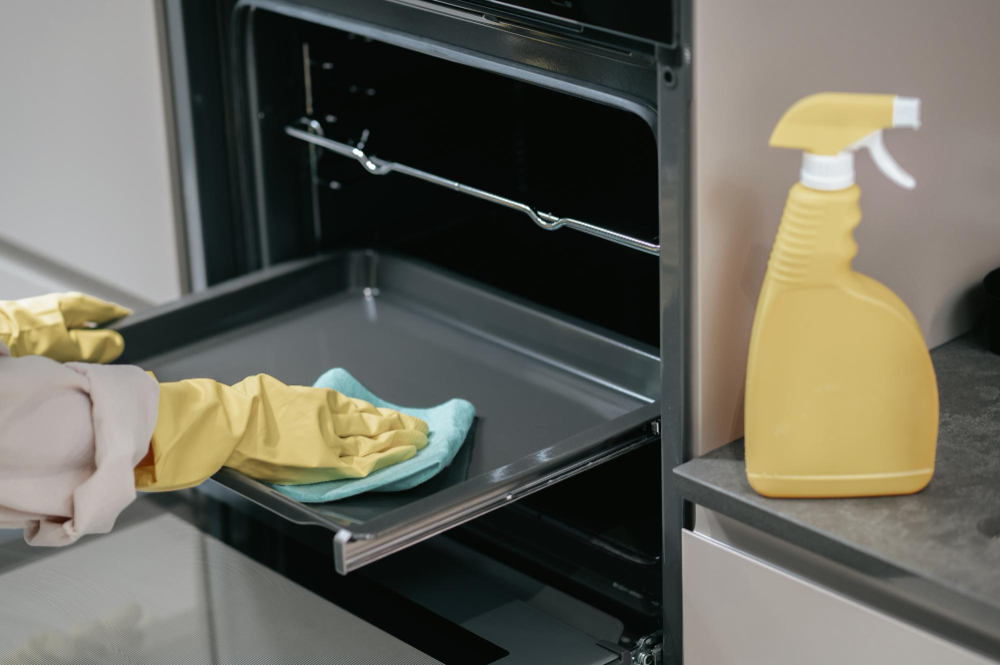Oven cleaning dissolves metal and should only be used on it in extreme circumstances. You might be wondering how to repair the harm that has already been done. You won’t be able to fix the etched surface if you can’t access it for mechanical polishing. You won’t be able to cure it using chemicals, but you might be able to polish it. Instead of buffing by hand, use a metal polish, which is best done with a buffing pad set to a battery-operated drill. Make sure the oven cleaner is thoroughly cleaned first. Today’s appliance designs have aluminum trim inside the oven, which produces this expected consequence.
What is a good aluminum cleaner to make at home? Always remember to avoid alkaline materials while preparing your aluminum cleaner. Baking soda and ammonia are examples of alkaline-containing goods.
Although baking soda is a handy all-purpose cleaner, it damages aluminum things since it can leave stains on the surface and discolor them. So, if you’re looking for a good DIY aluminum cleaning, think about gently acidic items. Some folks suggest vinegar and baking soda, so we think you’ll have to experiment to discover which works best for your oven’s aluminum trim.
Vinegar can be used to clean a variety of materials. For example, lemons may be used to clean and freshen a combination of aluminum products. You can clean aluminum goods using one of these methods at home. In addition, steel wool can be used to get rid of stubborn oil and stains.
Can I Use Oven Cleaner on Aluminum Pans?
We do not recommend utilizing the oven cleaner method circulating on the internet because the caustic chemicals in oven cleaners can quickly erode or chemically harm the metal, causing practically anything to stick to it in the future.
Etched aluminum pans are bad news, period. If you need to clean your aluminum pans, fill the pan with water until it reaches the burnt-on food, add white vinegar, and bring it to a boil. Reduce the heat and cook the cleaning solution for 20 minutes.
Pour off the liquid, let the pan cool enough to touch, and brush off as much of the scorched muck as feasible with a nylon scraper or wooden spoon.
Repeat the method if there is still a lot of burnt food. Next, it’s time to break out an oxalic acid mixture that’s safe for food preparation once you’ve gotten to the last thin layer. Sprinkle it over the damp bottom of the aluminum pan, allow it to seep for a few seconds, then massage it to the surface with a towel.
What Cleaners Are Aluminum Safe?
You can use dish soap on aluminum pans. However, if caustic chemicals already scratch your pans, you may need to use aluminum restorers.
Pots and pans are the most prevalent aluminum item(s) found in households. Unfortunately, the blackening of aluminum pots and pans is caused by regular use and incorrect cleaning. Furthermore, grease and some substances can dull and discolor aluminum, necessitating a thorough, deep clean to return it to its original sheen.
Clean the object as usual with dish soap and water before beginning the deep cleaning process to remove blackness from aluminum pots and pans. This procedure doesn’t have to be meticulous; the purpose is to remove food particles and some grease and oil.
Acidic cleaning solutions are effective in removing grease and stains off aluminum utensils and restoring their luster! In this instruction, we’ll use a natural cleaning solution consisting of one lemon juice, half a cup of vinegar, and plenty of water to fill half (or more) of the utensil. Place the pot on the heat and allow the water to simmer for at least 10 minutes after adding the ingredients.
Allow the pot and cleaning liquid to cool before scrubbing the inside with a non-abrasive brush. To remove tough stains and restore the luster of your aluminum, a little elbow grease is required. If the water becomes excessively contaminated, rinse the utensil and clean it with dish soap and a scrubber. Because the boiling process removes tenacious stains while removing grime, regular cleaning will be sufficient to clean aluminum pots and pans thoroughly. Finally, rinse and dry the item to complete the process.
How Do You Clean Aluminum Oven Parts?
To keep aluminum things clean and shining, all they need is a good dusting with a soft, clean cloth regularly.
However, grease and grime can cause the metal trim of ovens to get dirty, necessitating a more thorough cleaning than a cloth can provide. While you’ll need something sturdy to get the job done, remember that various ordinary home items quickly damage aluminum. As a result, you must be careful how you clean metal to avoid causing harm.
Remember, however, that any aluminum object that has been lacquered, painted, or otherwise coated should be cleaned according to the coating’s requirements rather than the metal’s surface cleaning requirements.
You’ll need an acid-based solution to clean the item entirely. To remove the oxidized coating that forms naturally on aluminum surfaces, you’ll need an acid.
Commercially prepared acidic cleaners for the product you’re cleaning are available.
Tomatoes, lemons, and even apples can be used to generate DIY aluminum cleaning alternatives at home.
While acids like bleach or hydrofluoric acid can be used, they have numerous undesirable side effects and do not perform as well as acids found in natural products.
Aluminum is found in a wide range of products in our homes, but metal is susceptible to wear and tear and environmental variables. This causes ugly oxidation and tarnishing, giving the appearance of a “ruined” piece. However, you may restore goods to look as good as, or almost as good as new, if you employ the suitable approach for the type of metal. All you need to remove the stains and restore the sheen is a little know-how and some elbow grease.

